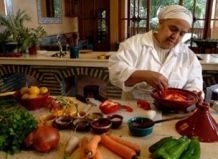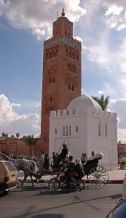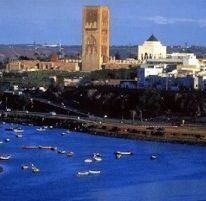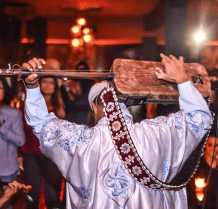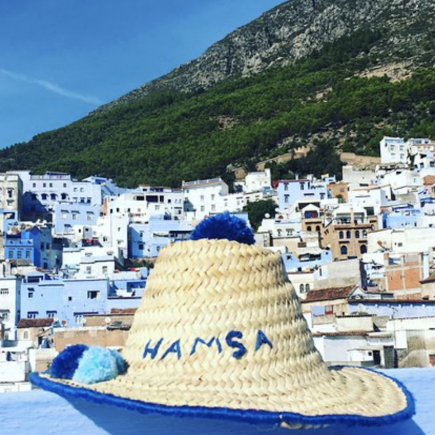
A Day in Chefchaouen
Chefchaouen, also known as the Blue Pearl of Morocco, is nestled in the Rif Mountains within the northwest region of the country. Founded in 1471 by Moulay Ali ibn Rashid al-Alami, a descendant of Muhammad Ali, the town is known for its charming, winding medina, cobblestoned streets with blue-rinsed houses. Just 5 minutes into your journey to this jeweled blue city, Chefchaouen instills the feeling as if one is participating in a magical children’s storybook.
Just three hours from Tangier, Chefchaouen is perfect for travelers interested in culture, art, and outdoor adventure activities. Local artisans in their ateliers line the maze-like alleys alongside boutiques that sell hand made goods not easy to find in other parts of Morocco such as wool garments and woven blankets. Silver jewelry, clothing, antiques, hand-painted crafts, artisanal goat cheese, and soap are some other items not to be missed in this blue washed city.
Chefchaouen’s blue color is a tradition that originates from the town’s former Sephardic Jewish population who came to Chefchaouen in the 15th century to escape the Spanish Inquisition. Blue is a color that resembles the sky and a reminder was a reminder of God, and therefore once permeated other Jewish cities in Morocco such as white and blue washed Essaouira, Asiliah, and Tetouan. Later the exiled Jews used Chefcahouen as a fortress to fight the invading Portuguese who were entering Morocco from the North in 1920, the Spanish seized Chefchaouen to form part of Spanish Morocco. It is this reason that Chaouen then became a Spanish speaking enclave.
If you’re interested in visiting the Blue Pearl of the North, then how you spend a day in Chefchaouen is essential.
Start Your Day, Breakfast With A View
Chefchaouen, set at an elevation of 564 m, is the easiest place to find picturesque spots where you can enjoy your breakfast. Consider staying at Ryad Lina, one of the best properties in town with magnificent views of the old city from their terrace. Or consider Hamsa Cafe, a traveler’s favorite run by two French-Moroccan sisters with a pastry degree. Hamsa serves seasonal homemade cakes, crepes, and offers a variety of daily freshly squeezed juices, along with a wide selection of teas and coffees. Located just outside of the Kasbah, near the Bab El Sor gates, the cafe is a perfect place to read a book or write for a few hours.
Stroll the Blue Washed Historic Medina
Stroll the Blue Washed Historic Medina and discover Chefchaouen’s cultural sites and artisanal goods. Start with the kasbah museum in the medina. The Kasbah of Chefchaouen belongs to the early 18th century and was built by the legendary ruler Moulay Ismail. It is fairly simple without architectural surprises however it is surrounded by gardens on the interior and exterior. Inside the Kasbah, you can visit the ethnographic museum containing antique weapons, musical instruments, and photographs of the old town. Step onto the museum’s roof and take pictures of a panoramic view of the Hispanic flavored town lined with blue and whitewashed houses, tiny balconies, tiled roofs and patios embellished with citrus trees.
Chefchaouen is known for its colorful hand-painted furniture and has some of the best examples; wool items and blankets are woven with patterns unique to the Ghomara Berber tribes of the Rif region are also available for sale. For those interested in a day trip excursion, there are several art and craft centers in the countryside where you can see artisans at work.
Plaza Uta el-Hammam
Next, visit the cobbled main square, Plaza Uta el-Hammam and where the striking 15th century Grand Mosque sits. The Mosque and its nearby buildings were built by Jewish refugees. Designed in Moorish architecture, the mosque was founded by the Grandson of Chaounen’s founder Ali Ben Rachid.
Ras el-Maa Waterfalls
Just footsteps outside of the Chefcahouen medina walls, to the east, is the “Head of Water”, Ras el-Maa waterfalls. These small falls are frequented by locals during the hot months too cool off and also serve as a place by women to do their laundry. Outside seating at a cafe nearby offers views of the falls.
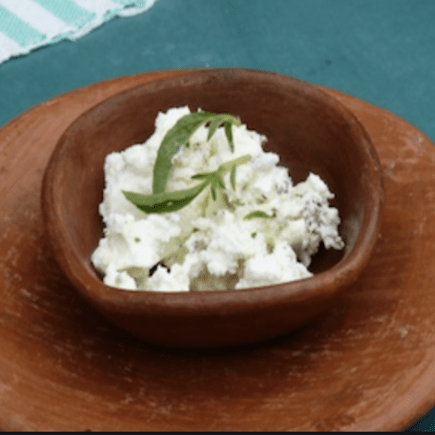
Coffee Break & Foodie Pitstops
On return from the Spanish Mosque, another romantic stop for a coffee break is at Cafe Tounsi. With views of the Fourara River, the Tounsi Cafe offers a memorable experience. With Tangier, the most literary city in Morocco being just two hours away, it is likely international Beat Generation writers like Allen Ginsberg, Paul and Jane Bowels, Edith Wharton, George Orwell and Moroccan writers Mohamed Choukri and Driss Chraibbi escaped to Chefhaouen to cure writer’s block of cafes like Tousni.
Book an Appointment at a Hammam, Moroccan Traditional Bathhouse
Morocco is known for its hammams, Moroccan bathhouses used by men and women for centuries. A Moroccan hammam is a traditional part of the Moroccan beauty and grooming rituals. Once a week, men, women, and children attend a hammam to deeply exfoliate their bodies with black soap. A hammam consists of a large steam room, with access to hot and cold water, and is considered a social activity. Even in the smallest villages in Morocco, you can find hammams; the steam is generated by a wood-burning furnace. Sometimes herbs like eucalyptus, peppermint, rosemary, or lavender or added to the steam-air to accelerate detoxification.
If you would like to experience the hammam ritual, try Lina Ryad & Spa which offers high-end luxury, inclusive of masseuse services, a private, heated pool. Other luxury services include facial treatments, manicures and pedicures, and full-body exfoliation. Advance reservations are required. Options for a mid-range hammam experience is Casa Hassan or consider one of the streetside places where you can find women and families.
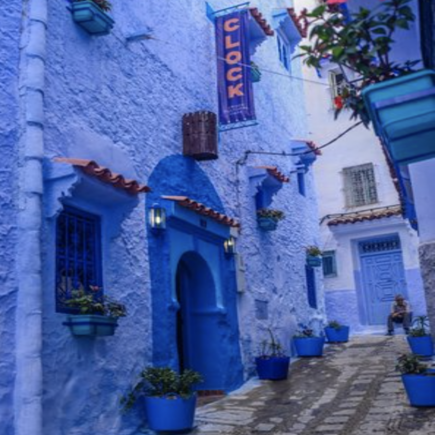
Lunch at Cafe Clock
A perfect lunch spot is the newest edition of Cafe Clock. The Chefchaouen location is four stories and offers breathtaking, uninterrupted 360-degree views. Try their famous camel burger or roasted chicken with lentils, a Chaouen staple dish.
For vegetarians, Cafe Cafe offers Moroccan tapas from Fes, vegetable b’stilla, gazpacho, and aubergine salad with goat cheese and ras el hanout (Moroccan spice with up to 45 ingredients). Cafe Clock is also an ideal place to consider at sunset and for nightlife as it offers Andalusian live music and storytelling. Other activities offered by Cafe Clock are a Cooking Class, Bread baking calligraphy lessons. Current film screenings and musical concert events as listed on their website.
The first Cafe Clock was founded in 2006 in Fes by Mike Richardson; a Marrakech kasbah location also exists. For over a decade, the cafe has been recognized as a cultural hub and promotes a cross-cultural exchange between locals and visitors.
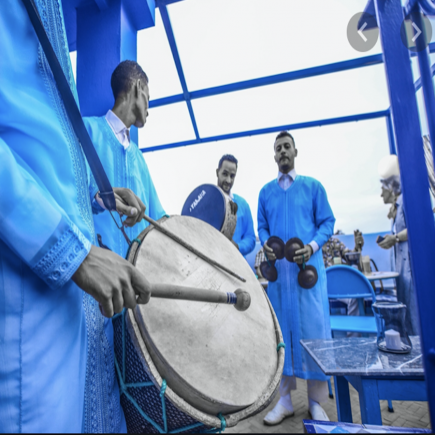
To support social impact projects in Morocco, Cafe Clock is a good resource. Their local causes include the Fes Medina Children’s Library, Friends of Fes Orphans, and the Moroccan International Women’s Association; for every camel burger sold, 10 dirhams ( 1 USD) are allocated to a cause of their choice. Cafe Clock also serves as a center for the Peace Corps and during the Ramadan Eid holiday, offers a box of staples to the 15 most disenfranchised families in the local community.
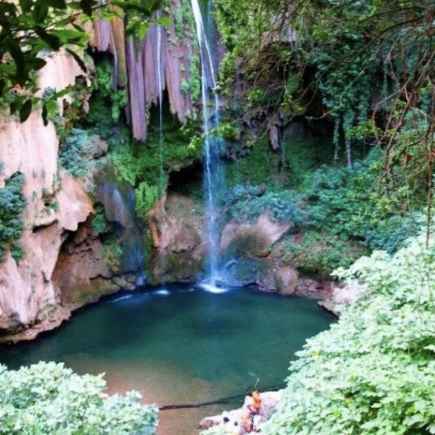
Extended Stay: Consider an Excursion from Chefchaouen to Visit the Spanish Mosque, Talassemtane National Park or the Akchour Waterfalls
For an extended stay in Chefchaouen explore the Spanish Mosque, a hike to this site is a popular choice. The mosque has a unique history. It was built during the 1920’s Rif War fought between the Spanish colonists and the Berber tribes. The views from the mosque are some of the best in the region. It has been renovated during the past decade however is not currently in use. You can begin your trek at Cafe Hamsa, the 1.4 km trail into the foothills of Chefcahouen takes approximately 45 minutes each direction. Trekking eastwards out of the medina and towards Ras el Maa waterfall ( Head of the Water) where you will bear a sharp right onto the Bouzaafer path, the hike to the Spanish mosque only takes 15 minutes. The path starts at an elevation at 652 m and raises to 704 m. Hikers of any level can enjoy the hike however those who feel out of shape can go at a slower pace and take the opportunity to stop and take photos Rif mountain scenery amidst an aerial view of the Blue Pearl. ChefChaouen stays cool throughout the day, however, the best time to enjoy the hike is in the early morning or evening.
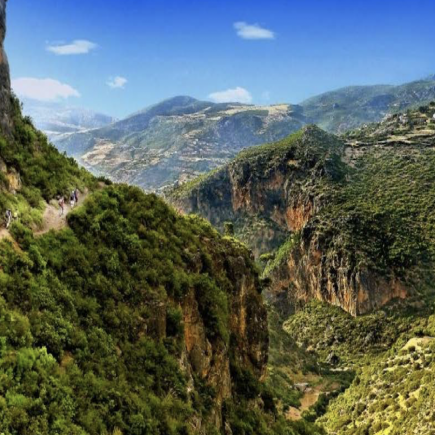
For a full day excursion, you can organize a private trekking tour of Chefchaouen’s Talassemtane National Park, which is 150 acres. A trek across Talassemtane typically starts in the oak forest and is done in muleteers through numerous fields rocky pathways surrounded by Moroccan fur trees and cedars en route to the summit. At sunset, trekkers can enjoy mountain landscapes of the occidental Rif.
Another option is are to visit the Cascades of Akchour referred to God’s Bridge. These waterfalls with their shades of turquoise are a little paradise set within the region and perfect outdoor adventure travelers who like to explore.
Getting to Chefchaouen
Chefchaouen is set in the high Rif Mountains, entering the Blue City must be done by land vehicle; we recommend a private car for the most comfortable journey. The closest airport to Chefchaouen is in Tangier, one of Morocco’s largest port cities. From Tangier to Chefchaouen directly, the journey takes three hours. For those interested in learning about Jewish heritage in Morocco or want to experience Morocco’s Little Jerusalem, the picturesque town of Tetouan is a must-stop destination. The White Dove, Tetouan, is an enjoyable overnight detour on the route to Chefchaouen. From Tetouan to the Blue Pearl, you will take winding roads offering views of the Rif Mountains and surrounding village landscapes.

